How to maintain a Topas septic tank in winter
Winter is an unpredictable time and sometimes merciless to communications, in particular to autonomous sewage systems. Even before the onset of cold weather, it is necessary to study the features of equipment operation in such conditions.
As an illustrative example, we can consider the maintenance of the Topas septic tank in winter, as well as the procedure for its conservation and re-preservation if the housing is used only in the summer.
The content of the article:
Features of winter operation of septic tanks
A septic tank is an autonomous sewerage treatment facility that does not depend on power supply. It allows you to reliably and safely dispose of a significant part of human waste. Devices of this type are usually divided into three or four sections, each of which performs specific functions.
Sewage flows into the septic tank, if necessary, is saturated with oxygen, processed by microorganisms and decomposed into relatively clean water and neutral sludge.
The silt settles below, the water is discharged into the ground or into a storage tank, from where it is then taken to meet the technical needs of the site, most often for irrigation.
To service systems of this type, separate mechanisms and elements are installed in the tank. These are airlifts, pumps for moving wastewater between individual sections of a septic tank, a pump for pumping out accumulated sludge, tank fill level sensors, filters, etc.
The main “employees” of the device are: aerobic and/or anaerobic bacteria. The former can work without problems in the absence of oxygen, while the latter free access to oxygen is extremely necessary.
Although advertising brochures claim that servicing septic tanks does not require large expenses, in practice you should not leave such a system without regular supervision and maintenance.Attentive attention to the condition of the cleaning point greatly reduces the number of equipment breakdowns and extends its service life.
The main factor influencing the operation of a septic tank in winter is low air temperature and freezing of the soil surrounding the tank.
It should immediately be noted that if the septic tank is correctly selected and correctly installed, then the cold will not adversely affect his work. In some cases, experts still recommend insulating the outer cover of the septic tank to protect the drains from possible freezing.

As you know, water, turning into ice, tends to expand. Freezing of drains can lead to equipment deformation or serious damage.
During the insulation process, it is necessary to take care of the conditions for the existence of bacteria that work inside the septic tank. It should be possible to ventilate those septic tanks that use aerobic microorganisms to process waste.
The active activity of bacteria inside the septic tank serves as additional protection against freezing of the device. During operation, microorganisms produce a certain amount of heat, so the contents of the septic tank usually have a temperature well above zero.
If routine maintenance of an autonomous sewer system is performed correctly, there will most likely be no problems with it in winter.
Specifics of the design of Topas septic tanks
Most often, septic tanks of the “Topas-5” or “Topas-8” type are used to service a private home.The performance of these devices is designed to regularly serve the needs of a family of five or eight people, respectively.
Beyond Performance septic tanks “Topas” may differ in modification. However, the maintenance of an autonomous sewer system of this type does not make much difference, and their structure is largely similar.
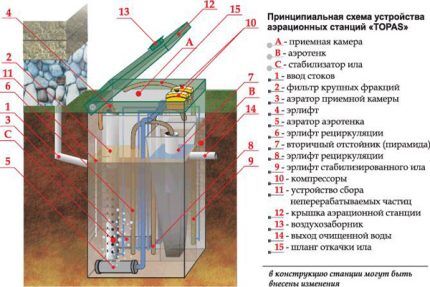
Topas septic tanks have four working chambers. The first chamber is a receiver in which the primary treatment of wastewater with anaerobic bacteria is carried out. The incoming masses are filtered to remove inclusions that are not suitable for bacterial processing.
In the second compartment, the wastewater is saturated with air using an aerator. This makes the environment more favorable for the life of aerobic microorganisms.
Aeration also helps separate solid contaminants from the bulk of the waste, which must be removed immediately. The air-saturated and already partially treated wastewater is moved into the third chamber using an airlift. This chamber usually has a pyramidal shape and acts as a sump.
In the secondary sedimentation chamber, the wastewater undergoes separation, as a result of which the activated sludge is separated from the liquid component of the processed sewage masses.
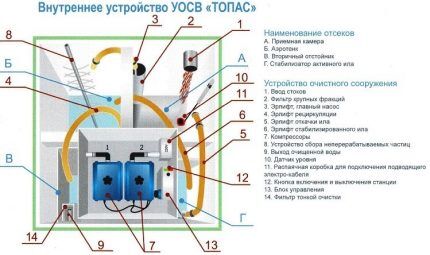
Then the waste is moved to the fourth compartment of the septic tank, where the fermentation process continues, although not as intense. Here the sludge settles to the bottom, and the water, after settling, moves to the storage tank. Sometimes the secondary sedimentation chamber also has the shape of a pyramid in order to create favorable conditions for the settling of neutral sludge.
From this last chamber, water flows into the ground treatment device. At this stage, the wastewater passes through a meter-long filter layer in an absorption well or through a system drainage perforated pipes with a geotextile shell.
If the geological section of the site is represented by water-repellent rocks, no further treatment is carried out, and the wastewater is discharged into a drainage ditch or into a centralized sewer network.
Saturation of the waste mass with oxygen that oxidizes it is provided by two compressors that are installed inside the device. There are also airlifts, filters, etc. Installations with forced pumping of wastewater are equipped with one or more pumps to stimulate the movement of the processed mass.
Technical devices require power, and mechanical devices require regular maintenance. For example, nozzles and air lifts should be periodically cleaned or replaced, compressors and pumps should be repaired.
Information about the design of the Topas septic tank is needed not only for proper operation and maintenance of the treatment point. It is necessary to know the design features in case of a system breakdown in order to quickly carry out affordable repair, if it is impossible to quickly deliver service company personnel.
How to maintain Topas in winter?
In winter, Topas septic tanks operate with approximately the same efficiency as in summer. However, in regions with average thermometer readings below - 20º in the winter months, the structure should be insulated to the depth of seasonal freezing in the region. The lid should be equipped with thermal insulation in any case.
If the thermometer does not show below - 20º, and at least 20% of water with household pollution enters the processing station, measures to insulate the skeptic for the winter may not be carried out.
The most sensitive to low temperature devices inside the device are compressors and a pump, if used. A noticeable cooling of the air around them can cause overload in the operation of devices and even their breakdown.
If winter operation is expected, then if the thermometer readings are below - 15º, you should not open the lid of the device unless absolutely necessary.
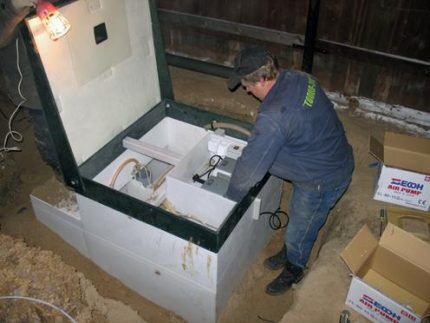
If the average temperature in the winter months varies between - 5º (-10º), there is no need to insulate the housing.
The container is made of durable polypropylene, and this material has a reduced ability to transfer heat. This allows you to maintain the temperature inside the septic tank almost unchanged even with the onset of slight frosts.

Inside the septic tank itself there is its own source of thermal energy. These are aerobic bacteria that actively produce heat during waste processing, as mentioned earlier.
In addition, the septic tank lid is additionally insulated extruded polystyrene foam - reliable and modern insulating material. Therefore, “Topas” usually does not require special preparation for winter, and its maintenance is carried out in the same way as in the warmer season.
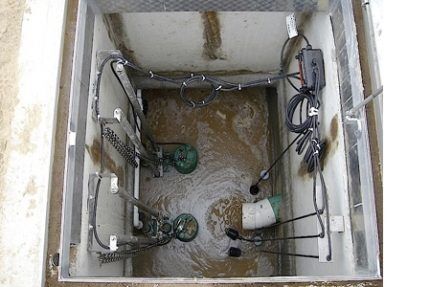
However, in areas with a harsh climate, or if there is a possibility of the septic tank freezing due to special operating conditions, it is still worth taking some additional measures to protect the device from frost. The selection of thermal insulation material is made in accordance with the actual climatic conditions in a particular region.
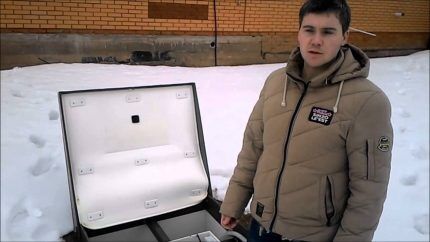
An important condition is good ventilation of the septic tank. The access of fresh air to the device must be constant, otherwise the aerobic bacteria inside will simply die.This situation is simply unacceptable, because if the fermentation process stops, an unpleasant odor will emanate from the device, and serious contamination will have to be eliminated.
Another significant moment in the winter is the overflow of the septic tank. This should not be allowed, as this can cause damage to the device’s mechanisms. This situation is also dangerous in the summer, but repairing a septic tank in the warm season is much easier than when frost sets in.
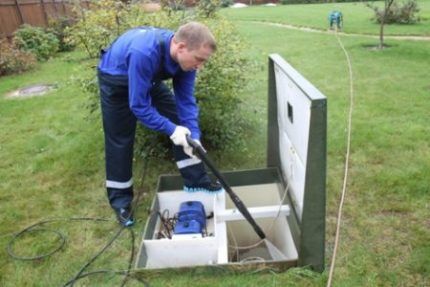
In the first year of operation of the septic tank, you should especially carefully monitor its operation. With the onset of severe cold, flaws may appear that were made during installation and were not discovered earlier. Such breakdowns should be repaired immediately so that the septic tank does not completely fail.
Many problems can also arise as a result of the influence of third-party factors, for example, due to improper installation of a sewer pipe or lack of high-quality insulation. If conservation of the sewage system based on the Topas septic tank is not carried out, then it must be serviced at least once every three months.
With details and septic tank maintenance rules, operated in winter, will familiarize you with the following article, which we recommend for reading.
Nuances of conservation and re-preservation
If the Topas septic tank is intended to be used seasonally, for example, from spring to autumn, then for the winter period the device should be preserve correctly. But if the sewer system is used in winter at least once a month, there is no point in preserving it; standard measures to prepare for winter are sufficient.
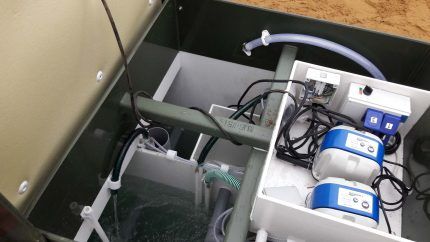
Preservation of the Topas septic tank is carried out as follows:
- Pump out the contents from each compartment of the septic tank.
- Rinse the septic tank according to the instructions.
- They wash pumps, airlifts, injectors and other equipment.
- Clean all filters.
- Fill the container with water to approximately 80% of the total volume.
- Turn off the power supply.
- The compressors are dismantled and stored in a warm place.
- Close the lid of the septic tank and insulate it additionally.
Work on pumping the contents from a septic tank is carried out in several stages. Each compartment of the septic tank is emptied separately and filled with clean water to 40% of its volume. Pumping and filling are performed several times until clean water is pumped out of the chamber. Each compartment is washed sequentially using this method.
It is forbidden to empty two compartments at the same time, especially since this should not be done with all cameras. Pumping and flushing should begin from the settling tank, then proceed to the aeration tank, then to the receiving chamber.
You cannot completely drain the water from the septic tank if it is installed in an area with a high groundwater table. It may emerge in the fall. In winter, the empty building will be squeezed out by freezing soils. Therefore, it is not left empty for the winter, but is filled with water approximately 1.8 m from the bottom of the septic tank.
When preserving a septic tank, some inexperienced summer residents simply drain all the liquid from it, acting by analogy with the procedure for preserving a heating system. This is completely the wrong approach. The mixture of water and sludge is a habitat for bacteria.Lack of water in the container will lead to their death.

Before preservation, airlifts with nozzles are washed, the power supply is turned off, technical equipment is removed and covered with an insulated lid for the winter. In this form, the structure should stand until it is re-opened.
When the septic tank is re-opened in the spring, this problem will appear; additional cleaning of the device will have to be carried out, as well as repopulation of it with microorganisms. It is also not recommended to drain all the liquid from the septic tank because there is quite a lot of pressure on the walls of the empty device from the outside.
When spring comes, the Topas septic tank must be properly re-opened. If the device has wintered normally, then restoring its functionality will be quite simple. First, remove the insulation layer from the lid and open it. You can immediately inspect the internal elements of the device and assess their condition.
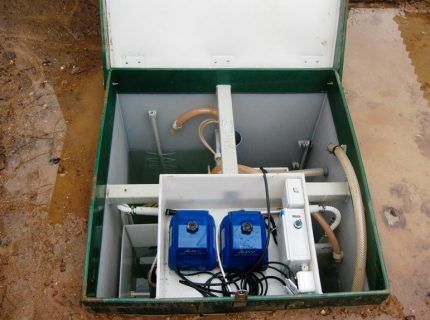
Then the removed compressors are installed in place, and power is supplied to the septic tank. Now you need to make sure that the fluid level corresponds to the manufacturer's recommended condition. If necessary, simply add the required amount of water to the device.
Now you can turn on the compressors and start the septic tank operating cycle to make sure that all components and mechanisms are working normally. If necessary, you can immediately wash and replace the filters.The first few days after re-opening, it is worth carefully observing the operation of the septic tank, assessing the smell of the resulting sludge and the purity of the outlet water.
If these indicators do not correspond to the norm, the composition of microorganisms may need to be adjusted. But if all conservation and re-preservation operations are performed correctly, then such a need does not arise, since the composition of bacteria for septic tanks is renewed spontaneously.
General recommendations for use
Proper operation and regular maintenance of the Topas septic tank is the best way to avoid breakdowns and malfunctions of the device. To begin with, you should monitor the nature of the wastewater that enters the sewer system of the house.
For example, some cleaning substances that contain aggressive components can cause the death of microorganisms inside the septic tank. This also applies to substances such as gasoline, alkalis, acids, etc. These beneficial bacteria combine equally poorly with fungal cultures.
Therefore, it is better to choose another method for disposing of moldy products. All non-degradable waste, such as pieces of plastic, plastic bags, cling film, should also not be sent to an autonomous bacterial treatment station.
These products will not harm microorganisms, but they can cause serious blockage of the mechanisms and even their breakdown. To protect the septic tank from such contaminants, it is recommended to install special protective nets on all drains in the house. You should check the effluent level in your septic tank at least once a week to make sure the unit is not overfilled.
This check can be performed more often, especially after the septic tank is re-opened.Situations when there is no power supply for some reason deserve special attention. In such cases, the amount of waste entering the sewer system should be limited, since the likelihood of the tank overflowing is very high.
If the power supply is often absent or disconnected for a long period, it makes sense to take care of an alternative source of electrical energy. The condition of the coarse filters must be checked monthly. If the filter is damaged or excessively dirty, it must be replaced to reliably protect the system from blockages.
The septic tank is cleaned quarterly, i.e. every three months. This is a simple operation; you just need to pump out the sludge that has accumulated below from the septic tank tanks. This mass can be used on the site as fertilizer. It is recommended to empty the storage facility for waste that cannot be bacteriologically treated every six months or more often.
Compressors have a membrane that wears out over time. Don't wait until the compressor breaks down. Two years after putting the septic tank into operation, it is recommended to replace the membranes with new elements. Such scheduled repairs of compressors will have to be performed every two years.
The aerators that are equipped with the septic tank may also require replacement. The estimated service life of these elements varies from 12 to 15 years. The more often and more thoroughly the maintenance of the Topas septic tank is performed, the more stable its operation will be. If the situation has changed and the load on the sewer system has increased, this is a good reason to conduct an unscheduled inspection of the condition of the septic tank and clean it.
Conclusions and useful video on the topic
General information about preparing autonomous sewer systems for winter, as well as the procedure for their preservation, is contained in the following video:
The process of conservation of the Topas septic tank is shown in detail here:
This video is dedicated to common mistakes associated with the conservation of septic tanks:
Topas septic tanks are relatively easy to maintain both in summer and winter. Regular maintenance, proper operation and additional insulation will allow this reliable and convenient autonomous sewage system to successfully withstand the harshest cold weather.
Please write comments in the block below. We are interested in your experience in installing treatment points for independent sewer systems and your opinion on the material presented. Ask questions, share useful information, post photos related to the topic of the article.




I also have a septic tank at my dacha, we’ve been using it for two and a half years now. Two winters have already passed, and every time my pump breaks. After the first winter I insulated the cover, after the second the pump failed again. Here it is written correctly - the pipe also needs to be insulated. This year I insulated the pipe, I hope that there will be no unpleasant surprises in the spring. I didn’t have any more global problems with the septic tank after the winter.
It is best to lay a heating cable in the pipe. It would also be a good idea to clean the septic tank before winter to avoid silting.
As for re-preservation, I always use the biological product “Bio Starter” to start it up after winter. As a result of this, my septic tank quickly comes into operation.